
Welcome to elizabethsnakes.com! I am David, a snake enthusiast living in Elizabeth, NJ. Many people don't know that Elizabeth is in fact full of snakes! You just need to know where to find them - they can often be shy and elusive. Some New Jersey snake species are more common outside of the city limits, in different parts of Union County NJ, but many types of snakes are indeed common in the more urban parts of Elizabeth. This guide is meant to help educate you about the beautiful snakes of Elizabeth, and to help you identify the most common snakes of Elizabeth, as well as the venomous snakes of Elizabeth that you should learn to recognize and avoid. If you want more detail, click here for my complete list of ALL snake species in Elizabeth. Remember the following:
- Most snakes of Elizabeth are harmless and don't want to encounter you
- Venomous snakes exist but are uncommon in Elizabeth, New Jersey
- Snakes eat rats and mice and are a valuable part of the New Jersey ecosystem
- Never kill a snake - if you leave a snake alone, it will leave you alone.
Common Snake Species in Elizabeth
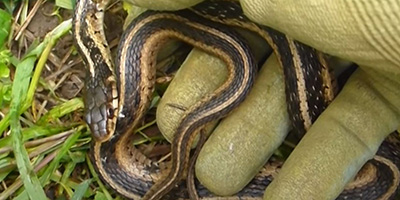 Eastern Garter Snake:
The eastern garter snake is the most commonly found snake species in all of New Jersey. They’re so common that you might even spot some in your own garden.
If you do see one, don’t panic. These snakes are not venomous, and they’re completely harmless. In fact, garter snakes can improve your home as they’ll eat worms, mice, and other pests.
These medium-sized snakes can grow up to three feet long, and they also come in a variety of shapes and colors. That said, they usually have dark green or black scales, along with three yellow stripes running down their entire bodies. The under-sides of their chin and belly are also yellow.
Eastern Garter Snake:
The eastern garter snake is the most commonly found snake species in all of New Jersey. They’re so common that you might even spot some in your own garden.
If you do see one, don’t panic. These snakes are not venomous, and they’re completely harmless. In fact, garter snakes can improve your home as they’ll eat worms, mice, and other pests.
These medium-sized snakes can grow up to three feet long, and they also come in a variety of shapes and colors. That said, they usually have dark green or black scales, along with three yellow stripes running down their entire bodies. The under-sides of their chin and belly are also yellow.
 Eastern Ribbon Snake:
The eastern ribbon snake is quite similar to the garter snake, and the two are frequently mixed up. These snakes have a black body with three yellow stripes and a yellow belly, making them almost identical to the eastern garter snake.
That said, these snakes mainly live in bogs, marshes, and other wetlands.
Eastern Ribbon Snake:
The eastern ribbon snake is quite similar to the garter snake, and the two are frequently mixed up. These snakes have a black body with three yellow stripes and a yellow belly, making them almost identical to the eastern garter snake.
That said, these snakes mainly live in bogs, marshes, and other wetlands.
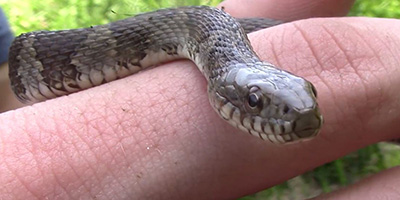 Northern Water Snake:
The northern water snake loves being near fresh bodies of water, which is why it can be found in Elizabeth, New Jersey.
As the name implies, these snakes are adept at swimming. In fact, they’re adept at hunting near the shore, as well as underwater. Their diets reflect their aquatic nature, as they mainly prey on fish, frogs, and other amphibians.
These snakes are generally harmless, and they’ll only consider biting you if they feel threatened. Northern water snakes tend to be a dark brown or black color, with some faint red bands running across their bodies.
Northern Water Snake:
The northern water snake loves being near fresh bodies of water, which is why it can be found in Elizabeth, New Jersey.
As the name implies, these snakes are adept at swimming. In fact, they’re adept at hunting near the shore, as well as underwater. Their diets reflect their aquatic nature, as they mainly prey on fish, frogs, and other amphibians.
These snakes are generally harmless, and they’ll only consider biting you if they feel threatened. Northern water snakes tend to be a dark brown or black color, with some faint red bands running across their bodies.
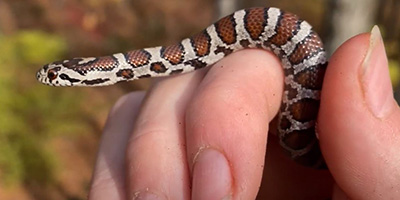 Eastern Milk Snake:
The eastern milk snake is another species that can be found in Elizabeth.
These snakes are fairly harmless, and they primarily feed on mice. Despite this, these snakes are frequently killed, as they tend to resemble some venomous species.
The eastern milk snake gets its name from the false belief that these snakes sneak into barns to drink cows’ milk. Yet the truth is that they were attracted to barns by the number of mice found in them.
You can recognize these snakes by their grey bodies which are covered with reddish-brown splotches.
Eastern Milk Snake:
The eastern milk snake is another species that can be found in Elizabeth.
These snakes are fairly harmless, and they primarily feed on mice. Despite this, these snakes are frequently killed, as they tend to resemble some venomous species.
The eastern milk snake gets its name from the false belief that these snakes sneak into barns to drink cows’ milk. Yet the truth is that they were attracted to barns by the number of mice found in them.
You can recognize these snakes by their grey bodies which are covered with reddish-brown splotches.
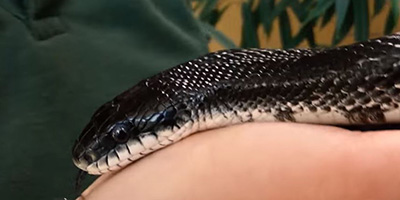 Black Rat Snake:
The black rat snake is New Jersey’s largest snake species. They’re also fairly abundant and can be found in all sorts of different environments.
These snakes are great climbers, and they’re able to get up trees without the aid of any branches. They’re also constrictors, meaning they kill their prey by squeezing them to death.
Despite what their name implies, the black rat snake isn’t picky about what it eats. In fact, these snakes will frequently use their climbing ability to get atop trees, where they’ll prey on any nearby birds.
As mentioned earlier, these snakes are New Jersey’s largest snake species, and they’re able to grow up to six feet long.
These snakes are black in color, but they’re noted to have white chins and bellies.
Black Rat Snake:
The black rat snake is New Jersey’s largest snake species. They’re also fairly abundant and can be found in all sorts of different environments.
These snakes are great climbers, and they’re able to get up trees without the aid of any branches. They’re also constrictors, meaning they kill their prey by squeezing them to death.
Despite what their name implies, the black rat snake isn’t picky about what it eats. In fact, these snakes will frequently use their climbing ability to get atop trees, where they’ll prey on any nearby birds.
As mentioned earlier, these snakes are New Jersey’s largest snake species, and they’re able to grow up to six feet long.
These snakes are black in color, but they’re noted to have white chins and bellies.
Venomous Snake Species in Elizabeth
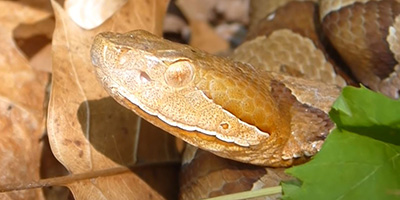 Northern Copperhead
Northern copperheads are one species to look out for. These snakes are notoriously venomous and can cause serious harm. In fact, they’re one of only two venomous species found in New Jersey and the only one that’s common to the city of Elizabeth.
These snakes are found in a number of different environments. You can find them in marshes and wetlands, as well as in plains or hills.
Like their habitats, the copperhead’s diet is also varied. These snakes eat everything from insects (as children) to mice, amphibians, lizards, birds, and even other snakes!
These snakes get their name from their reddish-copper bodies, which are marked by brown hour-glass shaped bands.
Northern Copperhead
Northern copperheads are one species to look out for. These snakes are notoriously venomous and can cause serious harm. In fact, they’re one of only two venomous species found in New Jersey and the only one that’s common to the city of Elizabeth.
These snakes are found in a number of different environments. You can find them in marshes and wetlands, as well as in plains or hills.
Like their habitats, the copperhead’s diet is also varied. These snakes eat everything from insects (as children) to mice, amphibians, lizards, birds, and even other snakes!
These snakes get their name from their reddish-copper bodies, which are marked by brown hour-glass shaped bands.
If you're unsure, you can email me a photo of the snake at info@elizabethsnakes.com and I will email you back with the snake's species. If you found a snake skin, read my Found a Skin? page, and you can email me a photo of the skin, and I'll identify the snake for you. If you need professional Elizabeth snake removal help, click my Get Help page, or see the below website sponsor I found, who provides that service.
Remember, the term is not poisonous snakes of Elizabeth, it's venomous snakes of Elizabeth. Poison is generally something you eat, and venom is injected into you. That said, dangerous snakes are very rare in Elizabeth. The few venomous snakes of Union County are rarely seen. But they are commonly misidentified, so learn about all the snake species of Elizabeth in order to correctly identify them. These snakes are usually also found in the surrounding towns of Union, Elizabeth, Westfield, Cranford, Linden, Summit, Rahway, Plainfield, Clark, Scotch Plains, Springfield Township, Berkeley Heights, Hillside, Roselle, Roselle Park, Kenilworth, Mountainside, Fanwood, Garwood, New Providence, Winfield, and the surrounding areas.
Read our article about:
What Am I Supposed To Do After I Trap A Snake?
elizabethsnakes.com domain and hosting costs made possible by the generous support of this sponsor:
